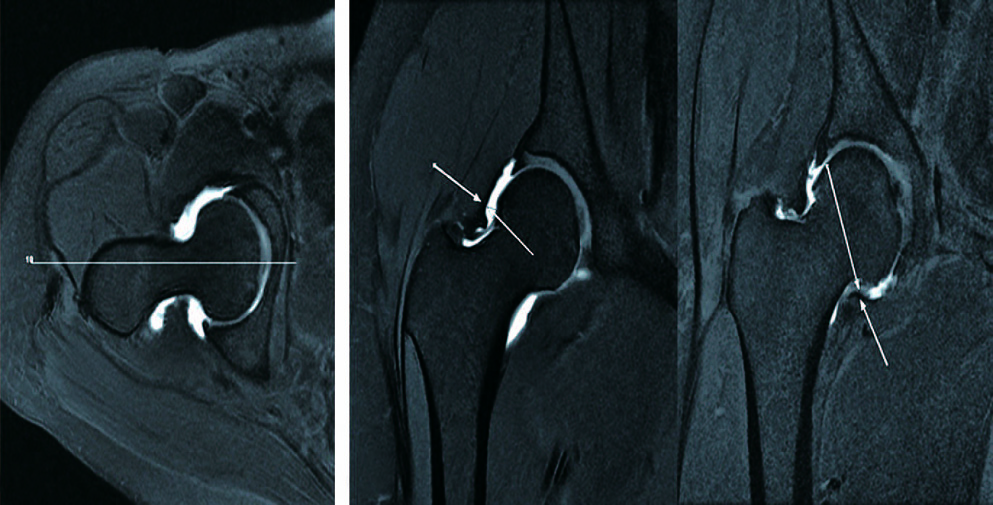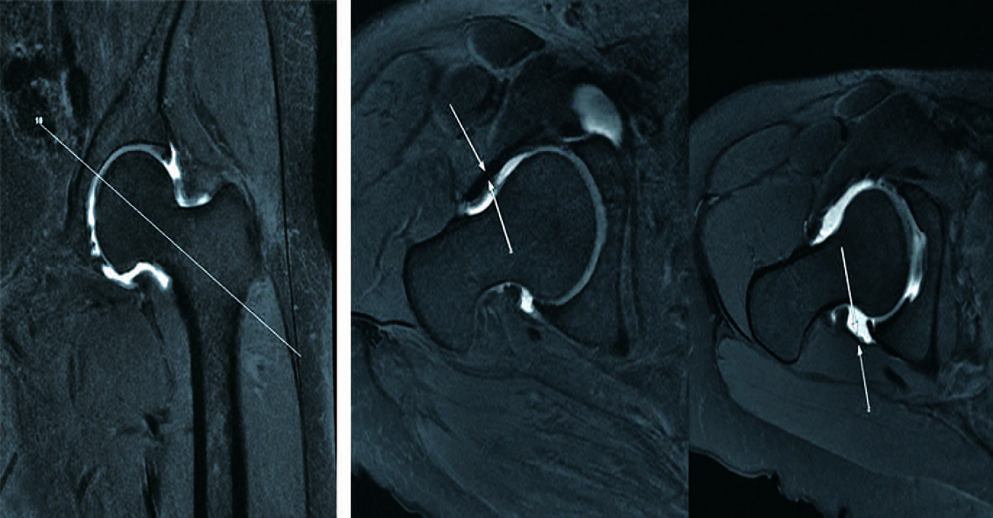Hip Pelvis.
2014 Sep;26(3):178-184. 10.5371/hp.2014.26.3.178.
Measurement of Capsular Thickness in Magnetic Resonance Arthrography in Idiopathic Adhesive Capsulitis of Hip
- Affiliations
-
- 1Department of Orthopedic Surgery, Konkuk University School of Medicine, Seoul, Korea. damioh@gmail.com
- KMID: 2054182
- DOI: http://doi.org/10.5371/hp.2014.26.3.178
Abstract
- PURPOSE
The clinical suspicion of idiopathic adhesive capsulitis of the hip (IACH) involves restricted range of motion and normal hip radiographs. The purpose of this study was to delineate the characteristic findings observed on magnetic resonance arthrography (MRA) by identifying the anatomical structures involved and their significance on clinical presentation of restricted range of motion.
MATERIALS AND METHODS
We retrospectively evaluated MRA's of 46 hips (44 patients) who suffered hip pain from September 2006 to August 2012 in our hospital. Of those, 10 cases (8 patients) with clinical suspicion of IACH were compared to 20 normal hip cases (control group). To identify anatomical evidence of adhesive capsulitis in the MRA's of the IACH group, capsular thickness was measured superiorly, inferiorly, anteriorly and posteriorly, and compared to that of the randomly selected control group.
RESULTS
Comparison of the MRA findings of the control group to that of the IACH group showed that there was a statistically significant increase in the mean thickness of the joint capsule superiorly and posteriorly (P<0.01), while comparison of examination findings revealed a statistically significant decrease in the mean range of motion (flexion 122.5degrees+/-5.5degrees/abduction 28.0degrees+/-2.8degrees/adduction 26.5degrees+/-2.4degrees/external rotation 30.5degrees+/-3.8degrees/internal rotation 25.5degrees+/-2.4degrees) in the IACH group.
CONCLUSION
A change in the capsular thickness on MRA is a common finding in IACH patients with the increase more evident in the posterior and superior capsules than the anterior and inferior capsules.
MeSH Terms
Figure
Reference
-
1. Chard MD, Jenner JR. The frozen hip: an underdiagnosed condition. BMJ. 1988; 297:596–597.
Article2. Lequesne M, Becker J, Bard M, Witvoet J, Postel M. Capsular constriction of the hip: arthrographic and clinical considerations. Skeletal Radiol. 1981; 6:1–10.
Article3. Caroit M, Djian A, Hubault A, Normandin C, De Seze S. 2 Cases of retractile capsulitis of the hip. Rev Rhum Mal Osteoartic. 1963; 30:784–789.4. Joassin R, Vandemeulebroucke M, Nisolle JF, Hanson P, Deltombe T. Adhesive capsulitis of the hip: three case reports. Ann Readapt Med Phys. 2008; 51:301–314.5. Lowe R. Adhesive capsulitis of the hip: a case report: an entity in question. Man Ther. 2013; 18:594–597.
Article6. Byrd JW, Jones KS. Adhesive capsulitis of the hip. Arthroscopy. 2006; 22:89–94.
Article7. Murphy WA, Siegel MJ, Gilula LA. Arthrography in the diagnosis of unexplained chronic hip pain with regional osteopenia. AJR Am J Roentgenol. 1977; 129:283–287.
Article8. Griffiths HJ, Utz R, Burke J, Bonfiglio T. Adhesive capsulitis of the hip and ankle. AJR Am J Roentgenol. 1985; 144:101–105.
Article9. Luukkainen R, Asikainen E. Frozen hip. Scand J Rheumatol. 1992; 21:97.
Article10. Modesto C, Crespo E, Villas C, Aquerreta D. Adhesive capsulitis. Is it possible in childhood? Scand J Rheumatol. 1995; 24:255–256.
Article11. Mont MA, Lindsey JM, Hungerford DS. Adhesive capsulitis of the hip. Orthopedics. 1999; 22:343–345.
Article12. McGrory BJ, Endrizzi DP. Adhesive capsulitis of the hip after bilateral adhesive capsulitis of the shoulder. Am J Orthop (Belle Mead NJ). 2000; 29:457–460.13. Rodeo SA, Hannafin JA, Tom J, Warren RF, Wickiewicz TL. Immunolocalization of cytokines and their receptors in adhesive capsulitis of the shoulder. J Orthop Res. 1997; 15:427–436.
Article14. Kabbabe B, Ramkumar S, Richardson M. Cytogenetic analysis of the pathology of frozen shoulder. Int J Shoulder Surg. 2010; 4:75–78.
Article15. Neviaser AS, Hannafin JA. Adhesive capsulitis: a review of current treatment. Am J Sports Med. 2010; 38:2346–2356.16. Neviaser AS, Neviaser RJ. Adhesive capsulitis of the shoulder. J Am Acad Orthop Surg. 2011; 19:536–542.
Article17. Hsu JE, Anakwenze OA, Warrender WJ, Abboud JA. Current review of adhesive capsulitis. J Shoulder Elbow Surg. 2011; 20:502–514.
Article18. Lefevre-Colau MM, Drapé JL, Fayad F, et al. Magnetic resonance imaging of shoulders with idiopathic adhesive capsulitis: reliability of measures. Eur Radiol. 2005; 15:2415–2422.
Article19. Lequesne M, Dang N, Bensasson M, Mery C. Increased association of diabetes mellitus with capsulitis of the shoulder and shoulder-hand syndrome. Scand J Rheumatol. 1977; 6:53–56.20. Jung JY, Jee WH, Chun HJ, Kim YS, Chung YG, Kim JM. Adhesive capsulitis of the shoulder: evaluation with MR arthrography. Eur Radiol. 2006; 16:791–796.
Article21. Wagner FV, Negrão JR, Campos J, et al. Capsular ligaments of the hip: anatomic, histologic, and positional study in cadaveric specimens with MR arthrography. Radiology. 2012; 263:189–198.
Article22. Looney CG, Raynor B, Lowe R. Adhesive capsulitis of the hip: a review. J Am Acad Orthop Surg. 2013; 21:749–755.
Article
- Full Text Links
- Actions
-
Cited
- CITED
-
- Close
- Share
- Similar articles
-
- Conventioinal MRI Finding in a Case of Adhesive Shoulder Capsulitis
- Adhesive Capsulitis of the Shoulder: MR Arthrography
- Adhesive Capsulitis of the Shoulder
- Computed Tomography Arthrography Findings of Idiopathic Adhesive Capsulitis of the Hip: An Analog of Adhesive Capsulitis of the Shoulder
- The Additional Effect of Tear after Passive Exercise during Distension Arthrography in Patients with Frozen Shoulder




